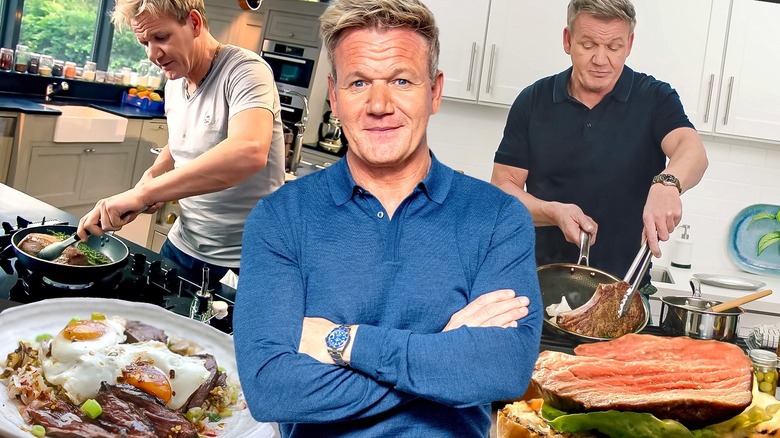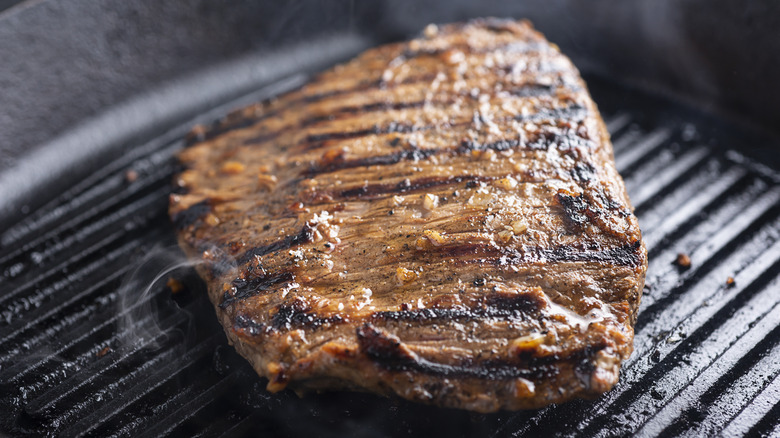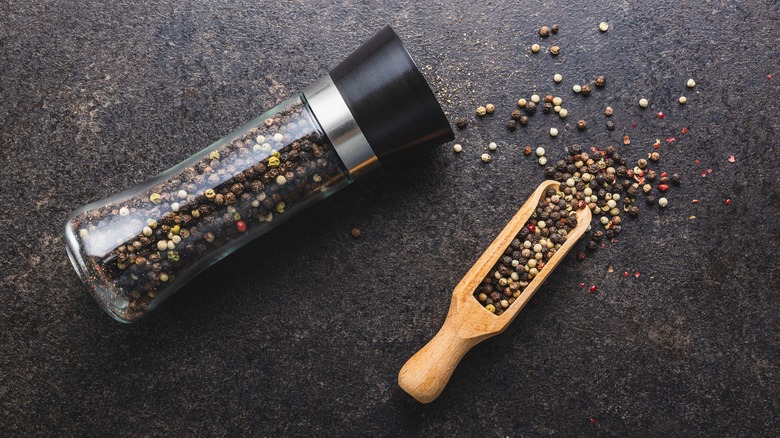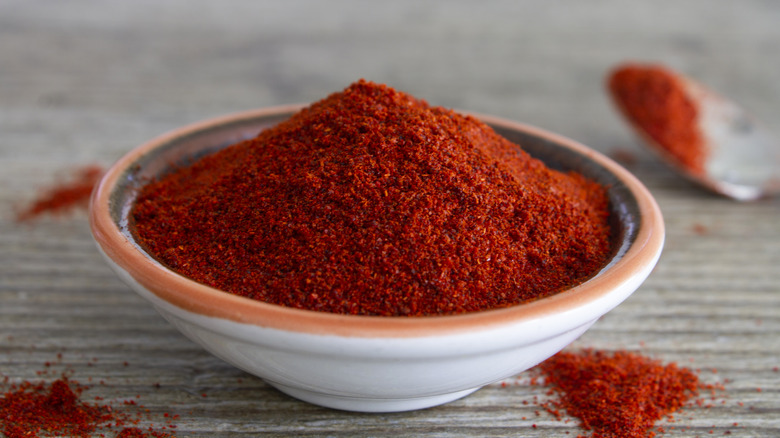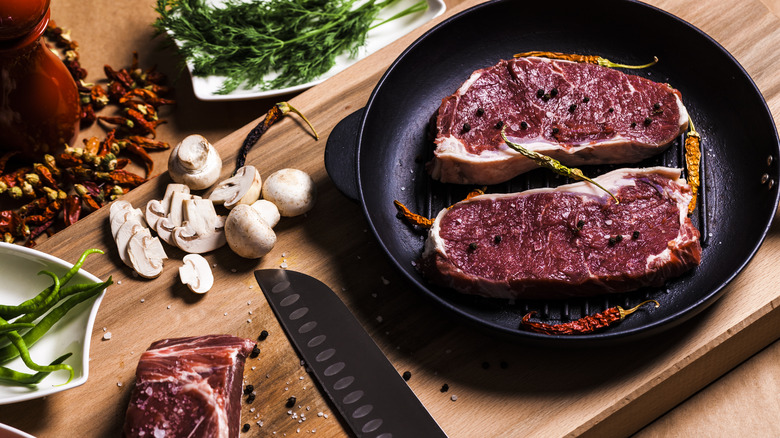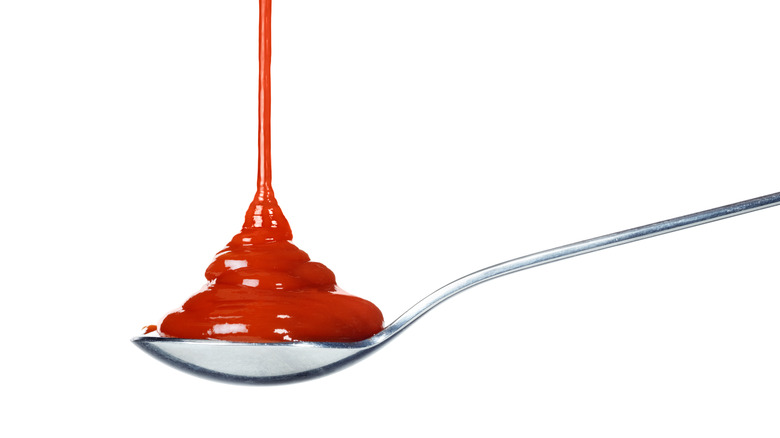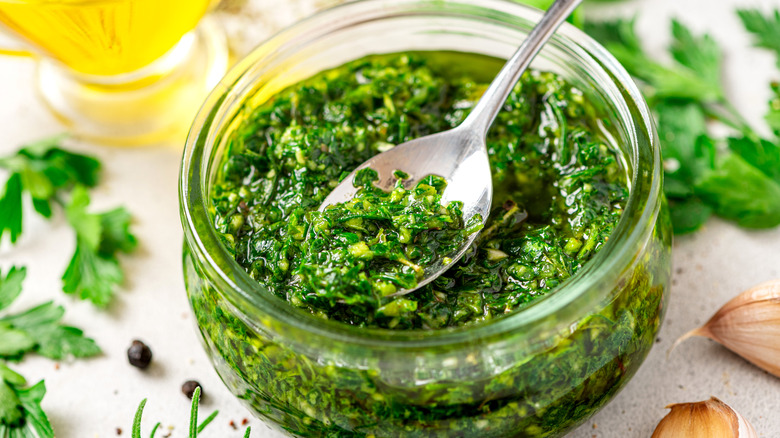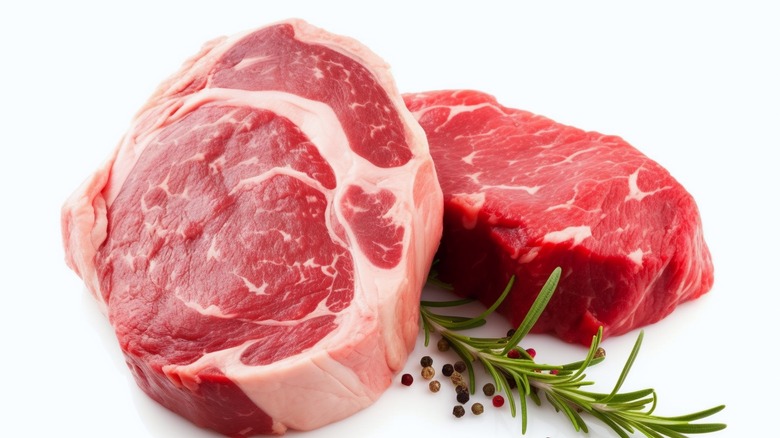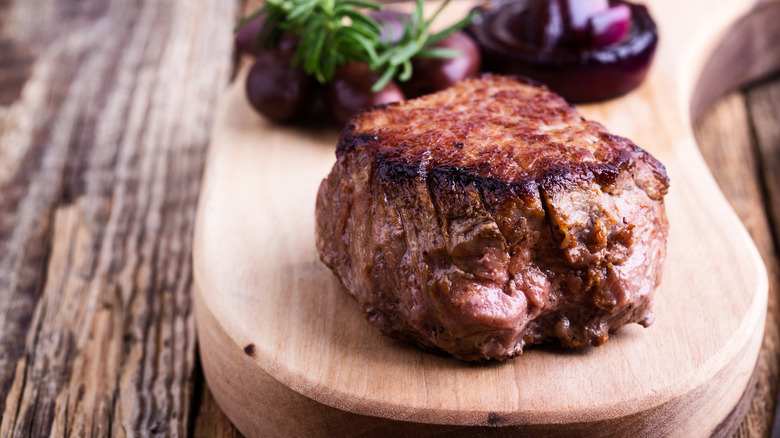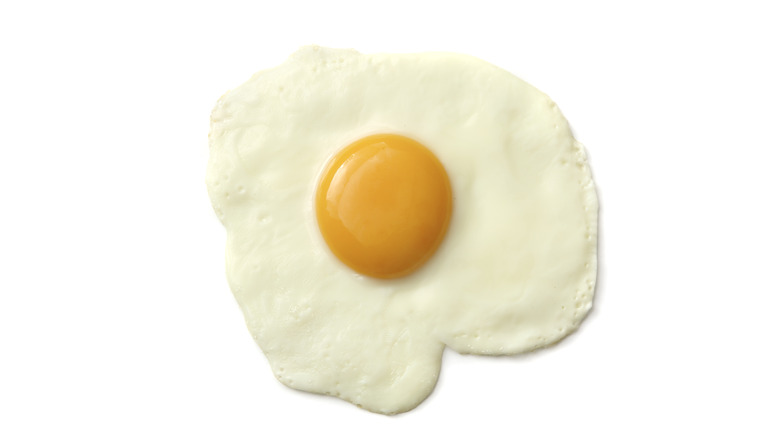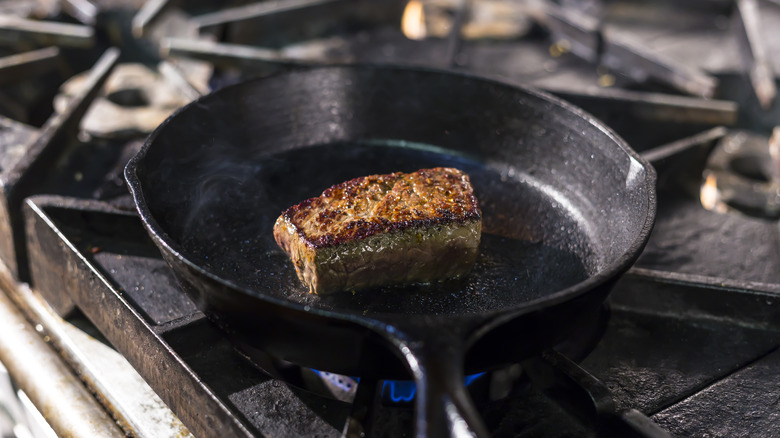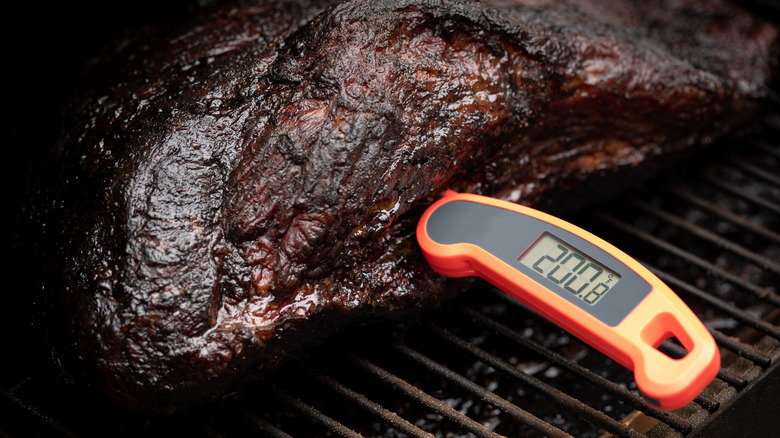Gordon Ramsay's 12 Tips For The Absolute Best Steak
Master chef Gordon Ramsay is known for many things, and food doesn't always make it to the top of the list. His temper, as seen on "Kitchen Nightmares" and other shows, is legendary, leading to the larger-than-life on-screen persona that we've come to know so well. But Ramsay's ability to prepare the perfect steak is just as legendary, and we ought not to forget it. Not only that, but he has a whole repertoire of tips and tricks for preparing steak at home, whether you need help with the cooking part, the seasoning, or any other aspect of the process.
So let us take a look at some of the ways in which Ramsay's steaks have become synonymous with perfection, with each cut cooked to precision and imbued with exceptional flavors. Whether you're dealing with a succulent filet mignon or a seared ribeye, following Ramsay's tips for the absolute perfect steak will not lead you astray. Indeed, what sets him apart in the realm of steak preparation is his unwavering commitment to quality and technique, so you know that when you stick with him, your ingredients will be well taken care of. The last thing you want to do when you drop a fortune on a good cut of meat is burn it or ruin it by following some second-rate recipe. Read on to learn how to achieve steak perfection.
Cook the steak at room temperature
Keeping your meat in the fridge right up until you're about to use it may seem like the right thing to do. After all, don't we want that beautiful, thick steak to remain as fresh as possible? Well, taking it out 20 minutes before you cook it isn't a significant enough amount of time to affect its freshness. In fact, the steak will remain cold for a while outside the fridge, and that's exactly the point: you actually want your steak to be room temperature when you start cooking it, or you might end up overdoing the exterior just to get the interior cooked through.
This is one of Gordon Ramsay's core tenets, and the reason for it is that a room-temperature steak will simply cook more evenly than a chilled one. As Ramsay told Tasting Table in an exclusive interview in January, "The rookie mistake that everyone makes is they cook the steaks ice-cold. They take them straight out of the refrigerator and they put them into the pan." The key thing to remember is that, as Ramsay puts it, "A steak needs to rest." And this is true whether you're talking about before or after you cook it.
Season steak with freshly ground black pepper
According to Gordon Ramsay, and many other celebrity chefs, such as David Chang, pre-ground black pepper that has been sitting for months on a grocery store shelf will accomplish next to nothing in terms of flavor. Instead, Ramsay says it's vital to use freshly ground black pepper -– as in, you have to literally grind the pepper onto your steak directly from a pepper mill, or you're doing it wrong.
And Ramsay takes it a step further, reminding us all that most pepper mills have a screw on top, and that this screw isn't just there for show. It actually has a purpose: it's meant to be used to adjust the size of the cracked pepper that comes out of the mill. If you want a finer ground of pepper, just tighten the screw. This is ideal for general seasoning and for lighter meats like chicken. For something a bit coarser, which is more suitable for those big fat steaks, loosen the screw. The coarse grinds will provide the perfect crust on your freshly seared steak.
Rub it with chili
Steaks are hearty, robust creatures, which means that if you want to add a bit — or a lot — of spice to yours, it can safely accommodate the extra punch without falling apart or turning into an amorphous blob of heat. But you have to get the technique right, which is why we're turning to Gordon Ramsay for help on this one.
In particular, Ramsay suggests using Aleppo pepper, which has a very powerful flavor, so it should be treated with care. In one of his best recipes, as posted on YouTube, he combines it with some brown sugar and coffee to balance out the flavors with sweetness and bitterness before rubbing the mixture onto the steak. And remember, as Ramsay points out, "The longer you put this rub on, the more flavor you get inside that steak." Fifteen to 20 minutes should do the trick. To get a good balance of spice on your steak, drop some of your mixture onto the plate before dropping the steak on it and seasoning the top side with more spice. And don't skimp: be sure to cover that steak in full, so no pink spots are visible. Then press the rub into the meat without forgetting about the sides.
Cook it in a pan
As a nation, we seem to be under this collective illusion that in order for a steak to be perfectly juicy and satisfying, it needs to have been cooked on a grill. Luckily for us, given the approaching winter and associated cold weather realities, Gordon Ramsay has come to set us straight, pointing out that you can cook a steak just as easily in a pan. You may not get that signature smokiness only an open flame can achieve, but there are plenty of other ways to create a beautiful flavor.
To get this tip right, you have to make sure you start with a hot pan. So turn on the heat while you season your steaks with salt and pepper on both sides. By the time you're done with that, your pan should be ready to welcome the oil followed by the steak, giving it a perfect sear right off the bat. From here on out, you can use your pan strategically in ways a grill would never allow. For one, you can lean the steaks up onto the side of the pan, allowing the sides of the steaks to sear without you having to hold them in place. The pan is also useful because you can throw in added flavorings, like crushed garlic, thyme, and butter, without losing the ingredients down the grates of the grill.
Hold the ketchup
When you've worked hard to cook a nice steak, using an expensive cut, and adding ketchup to it will throw all your efforts out the window, possibly insulting someone in the process. One person who was insulted by a TikTok video of a steak cooked entirely, and solely, in ketchup, was steak and general cooking expert Gordon Ramsay, who complained "I dressed up like this, and you serve me that?", referring to his tailored suit and the steak abomination that was being prepared — in the microwave, no less.
Indeed, as Ramsay says in the video, "no color, no flavor," which is probably why we don't see many recipes for steak that call for microwave cooking. High-temperature stove, grill, or oven cooking is needed to create a delicious crust on the outside of the steak and tenderize the meat, both of which are required to achieve the signature juicy taste we love so much in steak. Although ketchup's acid can help with the tenderizing part, it doesn't provide depth of flavor, especially when prepared in a microwave. Ketchup is a condiment that is meant to be kept on the side. For some people, so far off to the side that it's over there — in the trash can.
Top it with a chimichurri
A perfectly cooked steak doesn't need a lot of accouterments. Salt and pepper and a good cooking method are often all you need. But it's also okay to experiment with other ingredients and flavors, and for that, we present you with Gordon Ramsay's chimichurri suggestion, which he explains in this YouTube video.
First thing first: a good chimichurri will do nothing for your palate if it's sitting atop a sub-par steak. So first you have to heat your pan to volcanic temperatures and then generously season your bone-in rib-eye steak, remembering that, as Gordon explains, "you lose 30% of your seasoning, especially in the searing." After you've seared the steak to perfection, prepare the chimichurri by chopping up shallots or red onions, mint, cilantro, and fresh oregano -– without chopping them up too finely, or you may lose the flavors. Grate some garlic into your mixture and add smoked paprika, red wine vinegar, and a touch of olive oil. Squeeze some lemon juice into your chimichurri before spooning it onto your steak.
Choose the right cut
One of the best ways to ensure a successful outcome with any recipe is to use good ingredients, and nowhere is this truer than with steak. A bad-quality cut of meat will get you nowhere. If you want your dish to turn out perfectly, you have to find the perfect cut of meat. Luckily, Gordon Ramsay has put together a guide to help you choose your cut, whether you're looking to make a steak sandwich, seared steak, or anything else.
For instance, he chooses filet mignon to make his steak sandwiches, because "it's the most tender," as he explains in his YouTube video on the subject. This cut of meat has fewer muscles, which in turn, leads to softer, more tender meat. Or if you're looking for something a little less expensive but still high in flavor, go for the rump, which is ideal for stir fries or for barbecue cooking. But it can be hard to remember all the different names of the cuts, as there are so many, with each one boasting its own unique flavor and texture. So when in doubt, your ultimate resource is your butcher. Don't be afraid to ask them for their advice on which cut is best for a particular recipe.
Sear in a pan before baking
As Gordon Ramsay explains in this YouTube video, one of his favorite brunch recipes is the steak sandwich, which he calls "the daddy of all brunches." But before you even get to the assembly stage, you have to pay close attention to how you prepare the steak.
Start by choosing a tender filet, which you must then thoroughly season, from top to bottom, before placing it in the pan. Although the bulk of the cooking process for this filet is going to be in the oven, Ramsay recommends searing it in a pan first, making sure you get all sides. This helps to lock in the flavor of the meat and incorporate the taste of the garlic, thyme, and butter, which also go in the pan, and in the oven, with the filet. Be sure to place the filet on top of the garlic, which should be a simple head of garlic cut in half and placed face down on the pan. This will allow for a more even cooking process of the meat once it's in the oven, as the bottom of the steak will no longer be in contact with that very hot pan, which could lead it to cook faster than the top part.
Break a few eggs
One of the reasons many of us love steak so much is that it goes well with just about anything. Eggs, for example, have led to the ever-popular steak and eggs — and luckily, Gordon Ramsay has the perfect tips for turning this familiar dish into something quite elevated. Because even though you might be enjoying this dish for breakfast, it doesn't mean you get a free pass when it comes to effort.
As with any of Ramsay's steak recipes, be sure to prepare the actual meat properly -– meaning seasoned and seared to a delightful crisp on the outside, and cooked to rare or medium-rare on the inside. As you do this, add chopped onions and smashed garlic cloves to your pan, along with plenty of butter — just make sure you add this towards the end, or it may burn. Separately, fry the eggs with more butter, the same seasoning rub you used on your steak, scallions, and cilantro. To finish it all off, squeeze lime onto your steak and serve it topped with the juicy onions and fried eggs.
Don't neglect the sear
If you've watched any of Gordon Ramsay's cooking shows before, you may have noticed that he almost always sears his steaks, and not only that, but he seems to take great pleasure in it. It's a key step in the proper preparation of most steaks, which is why he insists on getting it right every time.
To make this happen for you, you'll need to remember a simple series of steps that must be completed in order. If you just pull your steak out of the fridge and plop it into any old, pan, any old way, you're unlikely to get the result you're looking for. Instead, you'll need to pay close attention to the science of searing, which dictates that you place a room-temperature steak on a very hot pan, which you may already know. But what you might not have picked up on yet, is the timing of the turn. You flip your steak too soon, and you risk not getting the caramelization of the natural sugars on the steak, leading to a bland flavor. Or you leave the steak on too long, and you burn the outside or overcook the inside. Thus, the perfect sear is about timing, and Gordon Ramsay's advice for searing the perfect steak is to always wait until you see color on the edges of the steak before you flip it.
Put it in a sandwich
There are many ways to make a steak sandwich, and Gordon Ramsay's YouTube channel offers two great ways to do it, one with a filet mignon, and another with a NY Strip. Each cut comes with different amounts of fat, so the cooking processes will necessarily differ slightly as you prepare the meat for the bread.
Both recipes involve one or two pieces of elevated ciabatta bread -– one of which is dusted with olive oil and grilled, and the other topped with Swiss cheese melted in a pan. As for the steaks, the fat in Gordon's strip loin helps give flavor to the onions that are cooked and caramelized in a pan, while celebrity chef Richard Blais opts for a leaner filet mignon that he later complements with a homemade aioli to make up for the lack of fat and associate flavor. Gordon lightly seasons his steak and rolls it flat with a rolling pin to achieve a deeper blend of flavors, while Richard dusts his filet with a hot spice rub and cooks it in butter. Each method is very different, but both chefs are able to assemble a delectable sandwich with these steaks. With these instructions in hand, so can you.
Blacken it
Gordon Ramsay talks a lot about the coveted browned color and crispy texture on the outside of a perfectly seared steak. But sometimes it's okay to go a bit overboard with the searing, as long as you're not overcooking what's on the inside. Indeed, it's possible to achieve a delicious blackened steak while the interior remains rare or medium-rare, and Gordon Ramsay has explained how in his recipe for blackened steak, fried rice, and fried eggs, which appears on his YouTube channel.
Start by marinating that steak in soy sauce, hoisin sauce, a bit of seasoning, and olive oil while you prepare the rice and eggs. Then start the all-important searing process of the meat in a very hot pan, allowing it to caramelize. With the soy sauce and hoisin in there, it will soon start to blacken, but don't let that scare you -– it's not burning. In fact, you should double down, and add more marinade while the meat continues to cook. When it's cooked to your liking, take it off the heat, cut it into thick strips, place it on the rice, and top with fried eggs. And the best thing about this recipe is that you can do it all in only 10 minutes!
